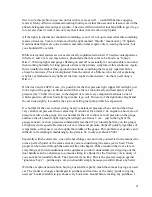
6
These cars were equipped with a 1570cc (1.6 liter... about 96 cubic inches) dual-overhead cam
all-aluminum engine, a design Alfa is justly famous for, four-wheel disk brakes, a five speed
transmission, and dual Weber carburetors. It included such (at the time quite uncommon)
comforts as roll-up glass windows, a simple one-pull-two-clips-it
“
s-up top which actually sealed
well against the weather, a real heater, and comfortable (if narrow) seating for two.
For comparison, most English sports cars of the time came with engines derived from sedans (at
best) or tractors (at worst), four speed transmissions, drum brakes, and single, or even worse,
multiple SU carburetors. They had "side curtain" windows (i.e. visqueen... plastic sheeting),
erector set tops, and heaters that might keep your right foot warm on a 50 degree day. Some
English designs neglected such
”
niceties
„
as exterior door handles and trunk (boot) lids
Indeed, the performance and sophistication of the Alfa Spider pretty much put it out of the
leagues of the
”
classic
„
English sports car makes. It also was about 25% more expensive when
new. Neither Germany nor France were producing open sports cars at the time, so the only real
competition the Alfa Spider would have for a long time would come from the original Lotus
Elan, a small, innovative automobile from the famous English engineer Colin Chapman.
Although the Elan design was four years old at the Spider
“
s introduction, it was still the only car
in the Alfa
“
s class. This would become a deeply ironic twist to the Alfa Spider
“
s history in the
distant future (FIAT also produced a Spider, but this was designed, and priced, more along the
lines of the lower-cost English makes).
A Duetto was prominently featured in the movie "The Graduate", starring Dustin Hoffman.
Indeed, the movie popularized the Spider so much that in later years Alfa created a "Graduate"
trim level in their US cars.
Because of this, and because the body style was only produced for about three years, Duettos
(and their round-tailed 1750 descendants) are the most valuable of all 105/115 Alfa Spiders.
They are incredibly fun, extremely distinctive cars even among Alfa circles. One note: in 1968,
Alfa did not import cars in the US because of tightening emissions standards. This would occur
again in 1970, probably because of problems with the SPICA injection system (more on this
later).
However, the interiors are quite primitive by today
“
s standards, with metal dashes, rubber mats,
and no center console. Wind noise is a problem with all Spiders at speed, especially so with the
uncarpeted models. And they were originally not equipped with rear anti-sway bars, making them
understeer very badly.
The interior ergonomics of the Alfa Spider would always receive a great deal of criticism from
the American automotive press, especially the
”
arms-out
„
driving position. By US standards, the
steering wheel is too close to the pedals, forcing the driver to
”
reach out
„
for it. It has been
reported elsewhere that this position was actually the result of research that revealed that an
”
extended elbow
„
driving position was actually less fatiguing over a long trip duration. This may
or may not be true. It is my experience that, while the position does take a bit of getting used to,







































